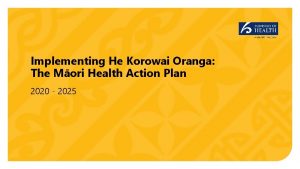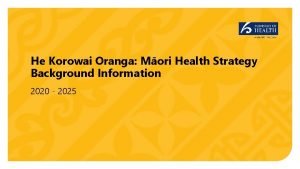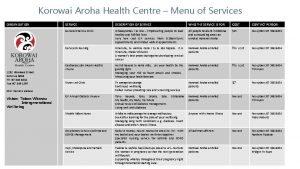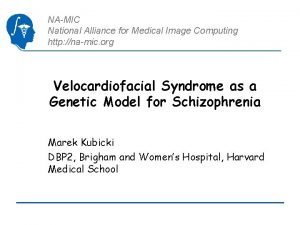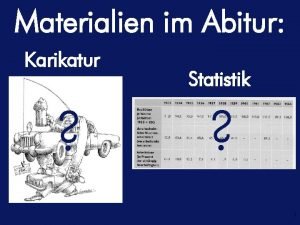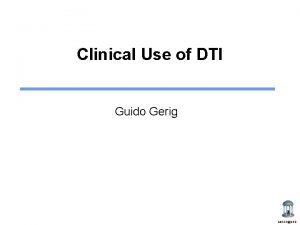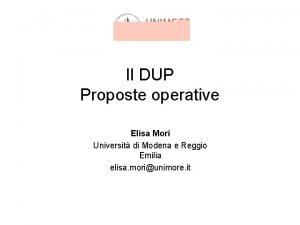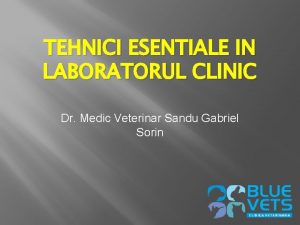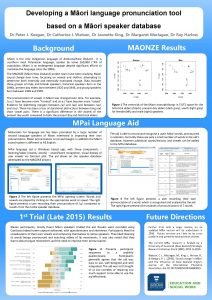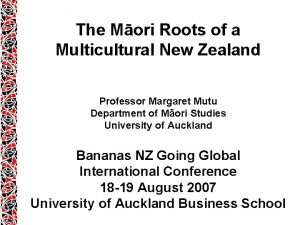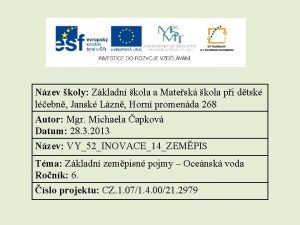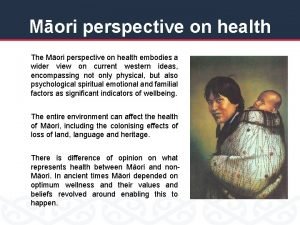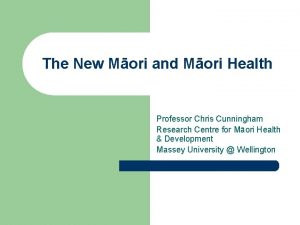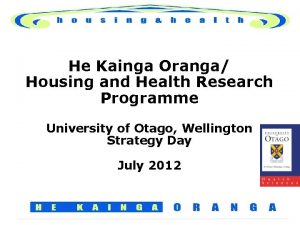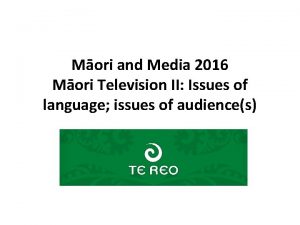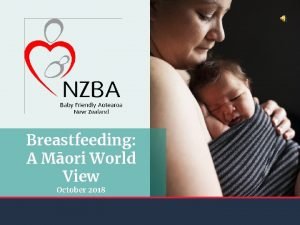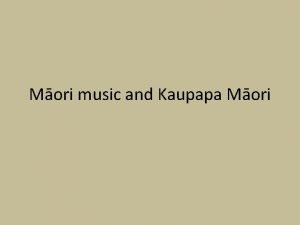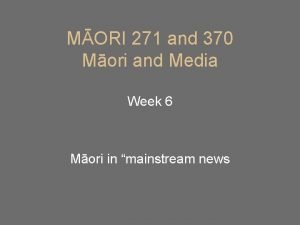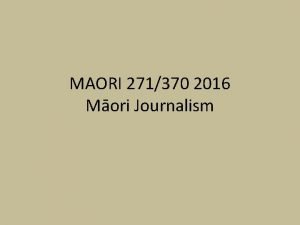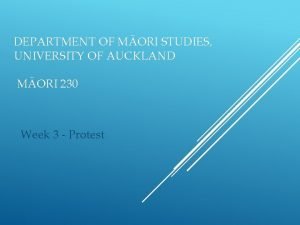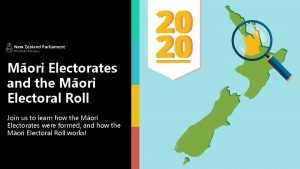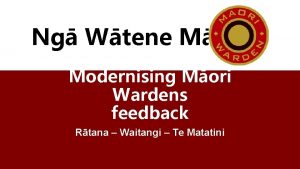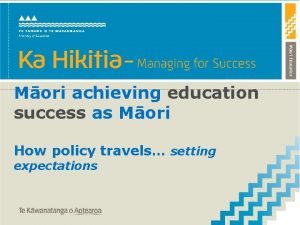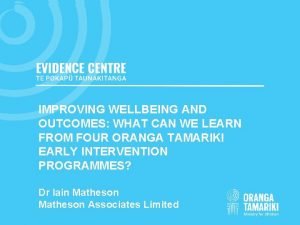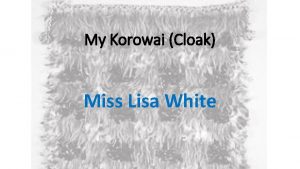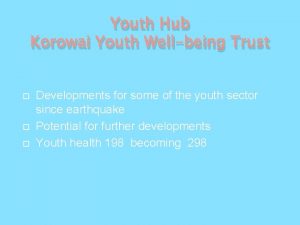Implementing He Korowai Oranga The Mori Health Action

































- Slides: 33

Implementing He Korowai Oranga: The Māori Health Action Plan 2020 - 2025

Purpose of this slide pack This slide pack provides the background to the development of the draft Māori Health Action Plan 2020 -2025 (the Action Plan). The Action Plan will guide the further implementation of He Korowai Oranga: the Māori Health Strategy (He Korowai Oranga). A discussion document that outlines the 8 priority areas for the Action Plan will be available at www. health. govt. nz/hko Our hope is that this background information and the discussion document will provide a strong foundation for further discussion. We want your help to identify the actions that will support Māori and the Crown in achieving pae ora – healthy futures for Māori. 2

Have your say The Māori Health Directorate at the Ministry of Health (the Ministry) invite you to share your ideas on the proposed areas for action and how they can be implemented. The final Action Plan will be released in November 2019. You can share your views and provide feedback: • at one of four regional wānanga • by email: maorihealth@health. govt. nz • through an online survey. The online hub for the Action Plan will provide up-to-date details of the development process, including engagement details. You can find the online hub at www. health. govt. nz/hko 3

Where have we come from? • New Zealand’s Health and Disability System • The New Zealand Health Strategy • He Korowai Oranga: the Māori Health Strategy • Implementing He Korowai Oranga: Whakatātaka and Whakatātaka Tuarua

New Zealand’s Health and Disability System Through the New Zealand Public Health and Disability Act 2000, the health and disability system is guided by overarching strategies, specifically the New Zealand Health Strategy and the New Zealand Disability Strategy. Also important are population-based strategies including He Korowai Oranga: the Māori health Strategy 2014; Whāia Te Ao Marama: the Disability action plan; and the Healthy Ageing Strategy. The Ministry has developed action plans, toolkits and guidelines to assist in the implementation of the various strategies. 5

New Zealand Health Strategy (2016) The New Zealand Health Strategy (2016) is intended to guide the Government’s approach to health and disability, including Māori health. It identifies priority areas and aims to ensure health services are directed at those areas that will generate the greatest benefits for New Zealand’s population, with a particular focus on achieving equitable health outcomes. He Korowai Oranga: the Māori Health Strategy expands on the principles and objectives of the New Zealand Health Strategy by providing more detail on how Māori health aspirations can be achieved. 6

He Korowai Oranga: the Māori Health Strategy He Korowai Oranga was originally launched in 2002, providing a tenyear outlook with an overall aim of whānau ora (healthy families). He Korowai Oranga 2002 set a new direction for Māori health development and provided guidance at a strategic level on ways for DHBs and providers to achieve Māori health improvement. 7

He Korowai Oranga: the Māori Health Strategy He Korowai Oranga was refreshed in 2014, to ensure its relevance and to continue to provide a strong platform for Māori health. The refresh expanded the aim of He Korowai Oranga from whānau ora to pae ora – healthy futures. Pae ora has three elements: mauri ora – healthy individuals; whānau ora – healthy families; and wai ora – healthy environments. 8

He Korowai Oranga 2002 He Korowai Oranga 2014 9

Implementing He Korowai Oranga: Whakatātaka and Whakatātaka Tuarua The implementation of He Korowai Oranga is the responsibility of the whole health and disability sector. Two Māori Health Action Plans were developed to guide the implementation of the original He Korowai Oranga: Whakatātaka Māori health action plan 2002 -2005, and Whakatātaka Tuarua: Māori health action plan (2006 -2011). Whakatātaka was used by the Ministry and DHBs to inform planning, resource prioritisation, and service development. Whakatātaka established a firm foundation for the health and disability sector to work towards improved health outcomes for Māori. 10

Implementing He Korowai Oranga: Whakatātaka and Whakatātaka Tuarua During the refresh of He Korowai Oranga in 2014, the Ministry did not develop a Māori health action plan to support its continued implementation. Since 2014, progress against the elements, directions, threads and pathways of He Korowai Oranga have been difficult to measure and monitor, particularly for DHB accountability and quality improvement processes. 11

Implementing He Korowai Oranga: Whakatātaka and Whakatātaka Tuarua Reflecting on the previous action plans is integral to developing the new Action Plan. The successful implementation of a new Action Plan will influence improved health outcomes for Māori, now and with an eye to the future. This will require: increased investment and prioritised resources better, stronger and more sustained leadership increased sector and community ownership to drive action interventions aimed at addressing priority areas for Māori new knowledge and insights from health interventions that are established • ongoing monitoring and evaluation of progress against the actions • • • 12

Where are we now? • A new Māori Health Action Plan • Māori health status today • Māori population trends and projections

A new Māori Health Action Plan The concept of pae ora, and the wider He Korowai Oranga strategy, continue to resonate strongly with the health and disability sector today. Implementing He Korowai Oranga will continue to be the responsibility of the whole health and disability sector. As the steward of the health system, the Ministry will be leading this process through the development and implementation of a new Māori Health Action Plan. The new Action Plan will be the first to put He Korowai Oranga (2014) into action and adopt the overarching aim of pae ora. The focus on pae ora encourages everyone in the health and disability sector to work collaboratively, to think beyond narrow definitions of health, and to provide high-quality, equitable and effective services. 14

A new Māori Health Action Plan The purpose of the new Action Plan is two-fold: to affirm Māori approaches and to improve Māori health outcomes. The Action Plan will be an expression of Crown and Māori health priorities and aspirations for health and wellbeing. The new Action Plan needs to consider the place of Māori across the health and disability sector, as consumers, as clinicians, as contributors and decision -makers. There is also a need to recognise and address inequities between Māori and non-Māori health outcomes. 15

Māori health status today Like all New Zealanders, Māori are living longer than ever before and the life expectancy for Māori has been increasing at a greater rate than non-Māori over the last decade. There are some improvements in Māori access to health care and Māori health outcomes, such as: • increased enrolment with community oral health services • an increase in at-risk Māori receiving cardio-vascular disease risk assessments • decrease in the gap between Māori and non-Māori rates of rheumatic fever. Notably, there is also no current disparity between Māori and non-Māori rates of tuberculosis. Reference: Ministry of Health. (2019). Māori Health Trends Reports 16

Māori health status today Despite the gains made, we know that the health system is not serving the needs of all New Zealanders to the same extent, and that Māori in particular do not experience the same health outcomes as other New Zealanders. Significant and enduring differences between Māori and non-Māori remain across many health outcomes. For example, Māori have higher rates of avoidable hospitalisations, and higher rates for many health conditions and chronic diseases, including cancer, diabetes, CVD, asthma, and mental illness. Māori are also more likely to be living with a disability than other New Zealanders. These disparities are even greater for younger Māori – particularly tamariki Māori. Reference: Ministry of Health. (2019). Māori Health Trends Reports 17

Māori health status today Many of these inequitable health outcomes can be explained by inequitable access to quality health care for Māori report encountering barriers to accessing care at a higher rate than the population as a whole. Māori also have a greater level of unmet need for primary health care than non-Māori. For example, Māori children are three times more likely than non-Māori children to have experienced an unmet need for a general practitioner (GP) and five times more likely than non-Māori children to experience unmet need for after-hours service due to lack of transportation. Additionally, cost was almost twice as likely to be a barrier to accessing a GP and after-hours services for Māori adults when compared to non-Māori adults. Reference: Ministry of Health. (2015). Tatau Kahukura: Māori Health Chart Book 18

Māori health status today There is a particular need to acknowledge and address the impact of colonisation, racism and discrimination as a determinant of health for Māori. Both within and outside of the health system Māori experience interpersonal and institutional prejudice, which can have a considerable impact on general wellbeing. Addressing institutional racism and discrimination would improve Māori interactions with the health system and their general wellbeing, therefore improving the enactment of Te Tiriti o Waitangi in protecting Māori. Reference: Came H, Doole C, Mc. Kenna B, et al. 2018. Institutional racism in public health contracting: Findings of a nationwide survey from New Zealand. Social Science and Medicine 199: 132– 9. 19

Māori population trends and projections The Māori population currently makes up about 15 percent of New Zealand’s total population, and is expected to grow at an increasing rate, while becoming more diverse and older. Compared to other populations in New Zealand, Māori are more youthful, with a relatively high proportion of the population at childbearing ages. By 2038, half the Māori population will be younger than 28. Over the same period the median age of non-Māori will increase from 40 years to 45 years. The age distribution of the Māori and non-Māori population groups are shown on the next slide. Reference: https: //www. stats. govt. nz/topics/population-estimates-and-projections 20

Age distribution of the Māori population, males and females, 2013 Age distribution of the non-Māori population, males and females, 2013 Source: Ministry of Health. (2015). Tatau Kahukura: Māori Health Chart Book

Māori population trends and projections These projected population changes will likely result in an increased demand for high-quality health services for Māori across the system. Over the coming years the Māori population is projected to grow by 16. 2 percent, compared to 13. 5 percent in the non-Māori population. The health system will need to have a focus on prevention and cross-sector alignment to respond to the growing Māori population and ongoing inequities in Māori health. The Action Plan needs to be dynamic and focused on the future, so that it can respond to the unmet needs of Māori today and the projected health needs of Māori as the population increases and changes. Reference: https: //www. stats. govt. nz/topics/population-estimates-and-projections 22

Where are we going? • Building on the gains • Māori aspirations and contributions • Crown aspirations and contributions • Priority areas for action

Building on the gains We have seen gains for Māori health through: • increasing Māori participation at all levels of the health and disability sector • improvements to the approach for assessing Māori health needs at a local population level • the use of DHB accountability mechanisms to address these needs. Better planning has been underpinned by better collection and administration of ethnicity data, more high-quality research, and the growing body of knowledge that tell us what works to improve health outcomes. It is important that we build on the gains and consider how we can continue progress within the new Action Plan. 24

Māori aspirations and contributions He Korowai Oranga acknowledges Māori aspirations and contributions as a key direction to achieving pae ora. “When we participate in hui like this we give a piece of our soul, and we ask that you take care of it. ” (Hui participant Mental Health and Addiction Inquiry 2018) In line with this framework, the Ministry is committed to reflecting Māori aspirations and contributions in this document. Over the years, whānau, hapū, iwi and Māori communities have made many important contributions. Most recently, Māori have provided extensive feedback and advice to government agencies as part of the Wai 2575 Health Services and Outcomes Inquiry, the Mental Health and Addictions Inquiry, and the Child and Youth Wellbeing Strategy. 25

Māori aspirations and contributions We want to respect and preserve the mana of those who have contributed to these past kōrero. The Ministry has acknowledged the main themes and priorities from previous Māori engagement and have used these to guide our thinking in developing a framework for the Action Plan Common themes and priority areas raised through these various hui include: • • • Māori in governance and leadership Rangatiratanga and mana motuhake Equity of access to services and equity of health outcome Mana Māori Investment in our Māori health workforce Addressing colonisation and racism Whānau-centred models of care Changes to funding partnerships The importance of mātauranga Māori Accountability Data, information sharing, and technology More detail on each priority, including alignment with the articles and declaration of Te Tiriti o Waitangi, is included in the discussion document. 26

Crown aspirations and contributions The Crown has an obligation under te Tiriti o Waitangi to address Māori health inequities and to promote Māori health development. These obligations are reinforced under the NZPHDA 2000, as well as He Korowai Oranga. In line with these responsibilities, it is intended this Action Plan will be supported by Government priorities, the Minister of Health’s priorities, and the work that is already underway in the health sector and beyond. In its stewardship role, the Ministry of Health has a responsibility to facilitate this process, in collaboration with Māori. 27

Government priorities Improving the wellbeing of New Zealanders and their families is a key government priority. The key objectives for this priority include: • ensuring everyone who is able to, is earning, learning, caring or volunteering • supporting healthier, safer, and more connected communities • ensuring everyone has a warm, dry home • making New Zealand the best place in the world to be a child. 28

Government priorities It is also important to note the changing landscape of Māori-Crown relationships in the emerging post-settlement context. The Government has identified building closer partnerships with Māori as one of its 12 priority outcomes. In line with the Government’s renewed commitment to building more meaningful relationships with Māori, the development of the Action Plan will demonstrate the Ministry of Health’s commitment to building closer partnerships with Māori as tangata whenua and stakeholders in a high quality equitable health system. 29

Minister of Health priorities The Action Plan will also support the Minister of Health’s priorities for the health and disability system. • Improving child wellbeing: The Action Plan will align with and support the Child and Youth Wellbeing Strategy, the proposed Oranga Tamariki action plan, and help support improved outcomes for all Māori tamariki and rangatahi • Improving mental wellbeing: There is an opportunity in the Action Plan to address and align with some of the recommendations of the Government Inquiry into Mental Health and Addiction, particularly in areas focused on improving Māori mental health outcomes. • Improving wellbeing through prevention: The Action Plan provides an opportunity to explore effective models of care (such as whānau-centred and holistic approaches) that support cultural responsiveness, health literacy and prevention. The Māori health action plan will also consider how it can contribute to the broader Whānau Ora work programme, led by Te Puni Kōkiri. 30

• Better population health outcomes supported by a strong and equitable public health and disability system: The Action Plan presents an opportunity to provide strategic direction for achieving equitable health outcomes for Māori, by aligning with other work streams such as responding to Wai 2575 Health services and outcomes kaupapa inquiry, the New Zealand Health and Disability System Review, the Whānau Ora review and the Mental Health and Addictions Inquiry. • Better population health outcomes supported by primary health care: The Action Plan provides an opportunity to identify priority areas for primary health care including a focus on prevention, and will work closely with the Wai 2575 Kaupapa Inquiry Stage One claimants on a series of actions for inclusion. 31

Priority areas for action We have developed a framework for the Māori Health Action Plan with eight priority areas that are a synthesis of Māori feedback, existing evidence, and wider government priorities. The framework aims to be responsive to the Te Tiriti o Waitangi and acknowledges both Māori and Government aspirations and contributions. After engagement and feedback from the sector, the final priority areas will guide where the health and disability system, in partnership with iwi, hapū, whānau and Māori communities, prioritise their time and resources over the next five years. The draft priority areas are presented in detail in the discussion document that will be available at www. health. govt. nz/hko 32

For more information: Visit: www. health. govt. nz/hko Email: maorihealth@health. govt. nz
 He korowai oranga
He korowai oranga He korowai oranga
He korowai oranga Korowai aroha health centre
Korowai aroha health centre Blessing a pounamu
Blessing a pounamu Polrn
Polrn Johann michael eder memento mori
Johann michael eder memento mori Thoracic cavity labeled
Thoracic cavity labeled Is bent double like old beggars under sacks a metaphor
Is bent double like old beggars under sacks a metaphor Obilježja baroka
Obilježja baroka Memento mori hkbp
Memento mori hkbp Excretory system of silkworm
Excretory system of silkworm Dravá ryba teplých moří
Dravá ryba teplých moří Susumu mori
Susumu mori Mori methode übungen
Mori methode übungen Guido gerig
Guido gerig Philippe de champaigne vanitas
Philippe de champaigne vanitas Mana mori
Mana mori Foris mori
Foris mori Istituto comprensivo di mori
Istituto comprensivo di mori Kati mori
Kati mori Elisa mori
Elisa mori žralokovidné
žralokovidné Ciervo herido topico
Ciervo herido topico In laboratorul de informatica daca se aseaza
In laboratorul de informatica daca se aseaza Renato de mori
Renato de mori Language spoken in athens
Language spoken in athens Naohiko mori
Naohiko mori Memento mori
Memento mori Mori language
Mori language Mori new zealand
Mori new zealand Zúžená část oceánů (moří) se nazývá
Zúžená část oceánů (moří) se nazývá Zúžená část oceánu se nazývá
Zúžená část oceánu se nazývá Dr matthew mori
Dr matthew mori Hrd program implementation
Hrd program implementation
